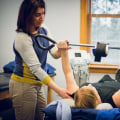Physical therapy is a medical treatment used to restore functional movements, such as standing, walking, and moving different parts of the body. It can be an effective treatment for medical conditions or injuries that cause pain, motor dysfunction, or limited mobility. Licensed physical therapists work in a variety of healthcare settings, including outpatient offices, private offices, hospitals, rehabilitation centers, nursing homes, home health care facilities, sports and fitness centers, schools, hospices, occupational settings, government agencies, and research centers. Physical therapists evaluate and record the patient's progress.
They help injured or sick people improve movement and control pain. They are often an important part of preventive care, rehabilitation, and treatment for patients with chronic conditions, illnesses, or injuries. A physical therapist uses a combination of exercise, stretching, practical techniques, and equipment to restore function or relieve pain. Patients usually go to a physical therapist after being referred by their family doctor.
Physical therapists diagnose and treat patients who have health problems or injuries that limit their ability to move or function in their daily lives. Pediatric physical therapists work to improve mobility, relieve pain, develop or restore function, and prevent or decrease permanent physical disabilities. In order for a person to practice as a physical therapist in the United States, they must obtain a doctor's degree in physical therapy and pass a state exam to become licensed. Your doctor may refer you to a physical therapist if you have an illness or injury that limits your physical ability to function.
Your therapist will establish a connection with you as treatment progresses, and emotional support will help you feel better faster. Physical therapists and physical therapist assistants help you maximize movement, manage pain, avoid surgeries and prescription drugs, manage chronic (long-term) conditions, and recover from and prevent an injury. A good therapist can adjust the patient's treatment plan to their lifestyle, including diet, sleep, and daily routine. Physical therapists can correct functional movement imbalances in patients with injuries or medical conditions, and they can also implement techniques to prevent injuries and improve performance. For example, if you like to run and you start to have knee pain, a physical therapist can evaluate your movements and develop a treatment plan to help you run without pain. If a patient works at a desk all day, the therapist will often prescribe postural exercises to counteract the negative effects of sitting, and may recommend that they stand up and walk several times during the workday.







